Energy Efficiency Improvement of Diesel–Electric Trains Using Solar Energy: A Feasibility Study
Abstract
:1. Introduction
- Reduce the specific final energy consumption from train operations by 30% compared to 1990.
- Reduce the specific average CO2 emissions from train operations by 50% compared to 1990.
2. Literature Review on the Use of PV Solar Panels in Diesel-Electric Trains
3. Case Studies
4. Methodology
- Quickly gauge a facility’s energy performance using benchmarking and evaluate energy costs and savings, GHG reductions, and financing viability.
- Determine the energy production and savings potential for any location in the world employing Archetypes.
- Verify the performance of implemented projects and find opportunities for further energy improvements.
- The type of solar panels (PV) used: Most solar panels on the market today fit into three categories: monocrystalline solar panels, polycrystalline solar panels, and thin-film solar panels. Each of these types has different characteristics. However, according to Sandy [32], the polycrystalline technology panel presents the balance between costs and performance. As a result, their efficiency increased to 18–20% in the last several years.
- The number of PV solar panels used: The solar panels are collections of solar cells. Multiple small solar cells spread over a large area can work together to provide enough power to be helpful. In the case of trains, the amount of energy produced depends on each PV solar panel’s dimension and the available surface atop each wagon. For this study, one type of wagon was used: the 50-feet standard, which means that 54.49 m2 are available on the roof of each train’s wagon [33].
- The considered losses: Solar energy is subject to multiple losses in the conversion system. The solar panels’ energy reaches the load and the batteries through the charge controller and the inverter. It suffers attenuation in each process whenever it passes through each component. First, solar panels (PV) can convert a small percentage, approximately 18%, of incoming solar energy into electricity. Second, the energy is stored in the solar batteries in the form of chemical energy, which can be used later to run the appliances, when there is no sunlight or during the night. Third, the battery provides energy by converting the stored chemical energy into DC electrical energy, with additional losses in the conversion process. Finally, the DC electrical energy passes through the inverter. The inverter’s essential function converts DC electrical energy into AC electrical energy. Today’s inverters have approximately 99% efficiency in converting DC into AC [34].
- The investment and O&M costs: The initial cost should include all capitalized preoperative and setup costs, as well as the cost of equipment, land, installation expenses, and EPC charges. At the same time, the O&M costs encompass routine maintenance of the equipment and minor part replacement to ensure maximum electricity generation [35].
- The financial parameters: Investing in a project requires understanding different economic variables to make an informed decision. Here are a few such variables:
- Inflation rate (%): The projected annual average inflation rate over the project’s life.
- Project life (year): The duration over which the project’s financial viability is evaluated.
- Debt ratio (%): The debt ratio reflects the financial leverage created for a project; the higher the debt ratio, the more significant the financial leverage.
- Debt interest rate (%): The annual rate of interest paid to the debt holder at the end of each year of the debt term.
- Debt term (years): The number of years over which the debt is repaid. The debt term is equal to or shorter than the project life [35].
- The solar electricity price: In general applications, RetScreen uses market electricity price (approximately 0.1 $/kWh) to determine the revenues associated with solar energy production. In this study, the energy produced by the PV solar panels replaces the energy produced by the auxiliary generator. The electricity price is thus considered to be the one produced by a diesel generator at 0.3 $/kWh [36].
- The GHG emission parameters: The RetScreen software requires the GHG emission factor (excluding transmission and distribution (T&D) losses) for the alternative electricity source. The units are tons of CO2 per megawatt-hour of end-use electricity delivered (t CO2/MWh). If any, the user enters an optional GHG reduction credit per equivalent ton of CO2 (t CO2). It is used in conjunction with the net GHG reduction to calculate the annual GHG reduction revenue. However, GHG reduction credits’ prices per equivalent ton of CO2 (t CO2) vary widely depending on how the credit is generated and how it will be delivered [37].
5. Results and Discussion
- Base case: We use this case for data calibration and validation. This section identifies the user inputs in RetScreen and presents the steps to extract profitability results for each studied case.
- Comparison and analysis: we compare and analyze the profitability for the six cases in terms of ROI (year), capacity factor (%), i.e., the actual percentage of the solar irradiation transformed into electricity, annual solar production (MWh), annual CO2 reduction revenue ($), and the percentage of each wagon’s consumption provided by solar energy. This value equals the ratio of yearly energy produced by PV solar panels over the wagon’s annual energy.
5.1. Base Case
- Fixed panels for the “solar tracking mode”, the most straightforward model installed on the train’s roof.
- Canadian Solar Poly-Si—CS34-365P-FG-KuDymond for the type of panels, with a total rated power of 365 W and total efficiency of 18.4%. At the same time, its high relative efficiency makes it a good choice.
- 27 PV solar panels are installed on the available area of each wagon’s roof. The panels’ total area is 53.6 m2, which is slightly less than the available area of the roof (54.49 m2).
- 5% and 1% are the losses for the solar panels and inverters. The choice of these values is recommended in the RET Screen guide.
- 2500 $/kW and 33 $/kW-year for the initial costs and O&M costs, respectively. An experienced worker has validated the choice of these values in the field of PV solar panels.
- 0.3 $/kWh for the annual electricity export rate, as explained in the methodology section. This is the cost of diesel generated electricity production, which is avoided.
- 1.075 t CO2/MWh and 50 $/t CO2 for the GHG emission factor (excluding T&D) and GHG reduction credit card, respectively, as shown in Figure 8. The emissions correspond to diesel generator electricity production, while the carbon credit corresponds to the market’s actual values.
- 2%, 20 years, 50%, 5%, and 10 years are the values used for the inflation rate, project life, debt ratio, debt interest rate, and debt term, respectively, as shown in Figure 9. These values’ choice corresponds to actual market conditions and similar PV solar panel projects.
5.2. Comparison and Analysis
6. Conclusions
Author Contributions
Funding
Institutional Review Board Statement
Informed Consent Statement
Data Availability Statement
Conflicts of Interest
Nomenclature and Symbols
| PV | Photovoltaic |
| COP21 | 21st Conference of Paris |
| IRENA | International Renewable Energy Agency |
| CER | Canadian Electrical Railways |
| O&M | Operation and Maintenance |
| T&D | Transmission and Distribution |
| GHG | Greenhouse gas |
| ROI | Payback period |
| UIC | International Union of Railways |
References
- Mylenka, T. Impact of COVID-19 on the Global Energy Sector. PV Magazine. Available online: https://www.pv-magazine.com/2020/04/24/impact-of-covid-19-on-the-global-energy-sector/ (accessed on 24 April 2020).
- Iea. COVID-19 and Energy: Setting the Scene. Sustainable Recovery. 2020. Available online: https://www.iea.org/reports/sustainable-recovery/covid-19-and-energy-setting-the-scene (accessed on 1 June 2020).
- Bp. Statistical Review of World Energy. 70th Edition. 2021. Available online: https://www.bp.com/content/dam/bp/business-sites/en/global/corporate/pdfs/energy-economics/statistical-review/bp-stats-review-2021-full-report.pdf (accessed on 1 July 2021).
- IRENA (International Renewable Energy Agency). Global Renewables Outlook: Energy Transformation 2050. 2020. Available online: https://irena.org/-/media/Files/IRENA/Agency/Publication/2020/Apr/IRENA_GRO_Summary_2020.pdf?la=en&hash=1F18E445B56228AF8C4893CAEF147ED0163A0E47 (accessed on 1 June 2020).
- IRENA (International Renewable Energy Agency). Renewable Energy Statistics 2021. Available online: https://IRENA_Renewable_Energy_Statistics_2021.pdf (accessed on 1 June 2020).
- IRENA (International Renewable Energy Agency). Renewable Energy Employment by Country. 2020. Available online: https://www.irena.org/Statistics/View-Data-by-Topic/Benefits/Renewable-Energy-Employment-by-Country (accessed on 1 June 2020).
- Agence Parisienne du Climat. Qu’est-ce que le COP 21? [French Edition]. Available online: https://www.apc-paris.com/COP-21 (accessed on 4 December 2018).
- IRENA (International Renewable Energy Agency). FUTURE OF SOLAR PHOTOVOLTAIC: Deployment, Investment, Technology, Grid Integration and Socio-Economic Aspects. A Global Energy Transformation Paper. November 2019. Available online: https://irena.org/-/media/Files/IRENA/Agency/Publication/2019/Nov/IRENA_Future_of_Solar_PV_2019.pdf (accessed on 1 November 2019).
- Eia. Energy Consumption by Sector. 2020. Available online: https://www.eia.gov/totalenergy/data/monthly/pdf/sec2.pdf (accessed on 1 June 2020).
- UNEP, UNEP DTU Partnership. UN Environment Program: Emissions Gap Report 2020. Available online: https://www.unep.org/emissions-gap-report-2020 (accessed on 9 December 2020).
- Mihlfeld & Associates. The 6 Modes of Transportation. Available online: https://blog.mihlfeld.com/the-6-modes-of-transportation (accessed on 6 October 2018).
- Iea. Rail. Tracking Transport 2020. 2020. Available online: https://www.iea.org/reports/tracking-transport-2020/rail (accessed on 1 June 2020).
- ORR Office of Rail and Road, Rail Emission 2019–2020. Available online: https://dataportal.orr.gov.uk/media/1843/rail-emissions-2019-20.pdf (accessed on 5 November 2020).
- Adele, B. Solar-Powered Trains: The Future of Rail? Railway Technology. Available online: https://www.railway-technology.com/features/solar-powered-trains/ (accessed on 12 September 2019).
- Moriarty, P.; Honnery, D. Global transport energy consumption. In Alternative Energy and Shale Gas Encyclopedia; Wiley Series on Energy; Jay, H.L., Jack, K., Thomas, B.K., Eds.; John Wiley & Sons: Hoboken, NJ, USA, 2016; pp. 651–656. [Google Scholar]
- De Blas, I.; Mediavilla, M.; Capellan-Perez, I.; Duce, C. The Limits of Transport Decarbonization under the Current Growth Paradigm, Energy Strategy Reviews 32, Elsevier. 2020. Available online: https://www.researchgate.net/publication/344255972_The_limits_of_transport_decarbonization_under_the_current_growth_paradigm (accessed on 1 September 2020).
- ORR Office of Rail and Road, Rail Infrastructure and Assets 2019–2020. Available online: https://dataportal.orr.gov.uk/media/1842/rail-infrastructure-assets-2019-20.pdf (accessed on 5 November 2020).
- Available online: https://www.reddit.com/r/trains/comments/agayt3/i_found_this_photo_on_americanrailscom_also_i (accessed on 12 September 2019).
- Vajihi, M. Solar-Powered Light Rail Vehicle and Tram Systems. Master’s Thesis, University of Roma, Roma, Italy, 2018. [Google Scholar]
- Available online: https://www.engadget.com/2017-07-18-india-first-solar-powered-train.html (accessed on 18 July 2017).
- Available online: https://createdigital.org.au/worlds-first-solar-train-byron-bay (accessed on 15 February 2018).
- High-Speed Euro Train Gets Green Boost from Two Miles of Solar Panels. Available online: https://www.theguardian.com/environment/2011/jun/06/tunnel-solar-rail (accessed on 6 June 2011).
- Available online: https://siteselection.com/issues/2012/mar/belgium.cfm (accessed on 1 March 2012).
- Kapetanović, M.; Núñez, A.; van Oort, N.; Goverde, R.M.P. Reducing Fuel Consumption and Related Emissions through Optimal Sizing of Energy Storage Systems for Diesel-Electric Trains. Appl. Energy 2021, 294, 117018. [Google Scholar] [CrossRef]
- Cipek, M.; Pavković, D.; Krznar, M.; Kljaić, Z.; Mlinarić, T.J. Comparative analysis of conventional diesel-electric and hypothetical battery-electric heavy haul locomotive operation in terms of fuel savings and emissions reduction potentials. Energy 2021, 232, 121097. [Google Scholar] [CrossRef]
- Afonso, J.L.; Lisboa Cardoso, L.A.; Pedrosa, D.; Sousa, T.J.C.; Machado, L.; Tanta, M.; Monteiro, V. A review on power electronics technologies for electric mobility. Energies 2020, 13, 6343. [Google Scholar] [CrossRef]
- Normanyo, E.; Sulemana, A.R. Using solar-powered 3-phase squirrel cage induction motors as prime movers for synchronous electric generators. Ghana J. Technol. 2021, 5, 11–20. [Google Scholar]
- De Almeida Carneiro, M.; da Fonseca Soares, D. Solar photovoltaic assistance system study for a Brazilian light rail vehicle. U. Porto J. Eng. 2020, 6, 35–45. [Google Scholar] [CrossRef]
- Discover How to Get Anywhere. Available online: https://www.rome2rio.com/fr/ (accessed on 5 June 2022).
- Tshiuetin Enterprise. Available online: https://www.tshiuetin.net/calendrier-septembre-2020.pdf (accessed on 1 June 2020).
- Available online: https://generatorist.com/list-of-electric-appliances-their-wattage-usage (accessed on 3 May 2021).
- Sendy, A. Types of Solar Panels: Which One Is the Best Choice? Available online: https://www.solarreviews.com/blog/pros-and-cons-of-monocrystalline-vs-polycrystalline-so (accessed on 5 May 2021).
- Railroad Equipment. February 2020. Available online: https://www.csx.com/index.cfm/customers/resources/equipment/railroad-equipment (accessed on 1 June 2020).
- What Are the Significant Losses in the Solar Power System? 2020. Available online: http://www.adityagreens.com/%20Losses%20in%20the%20solar%20system (accessed on 1 June 2020).
- RET Screen-NRCan. Available online: http://www.RETScreenExpert.rtx (accessed on 1 June 2020).
- Chauhan, A.; Saini, R.P. A review on Integrated Renewable Energy System based power generation for stand-alone applications: Configurations, storage options, sizing methodologies and control. Renew. Sustain. Energy Rev. 2014, 38, 99–120. [Google Scholar]
- RET Screen User Manual. Available online: http://www.unfccc.int/%20RET%20Screen%20Software%20Online%20User%20Manual (accessed on 1 June 2020).

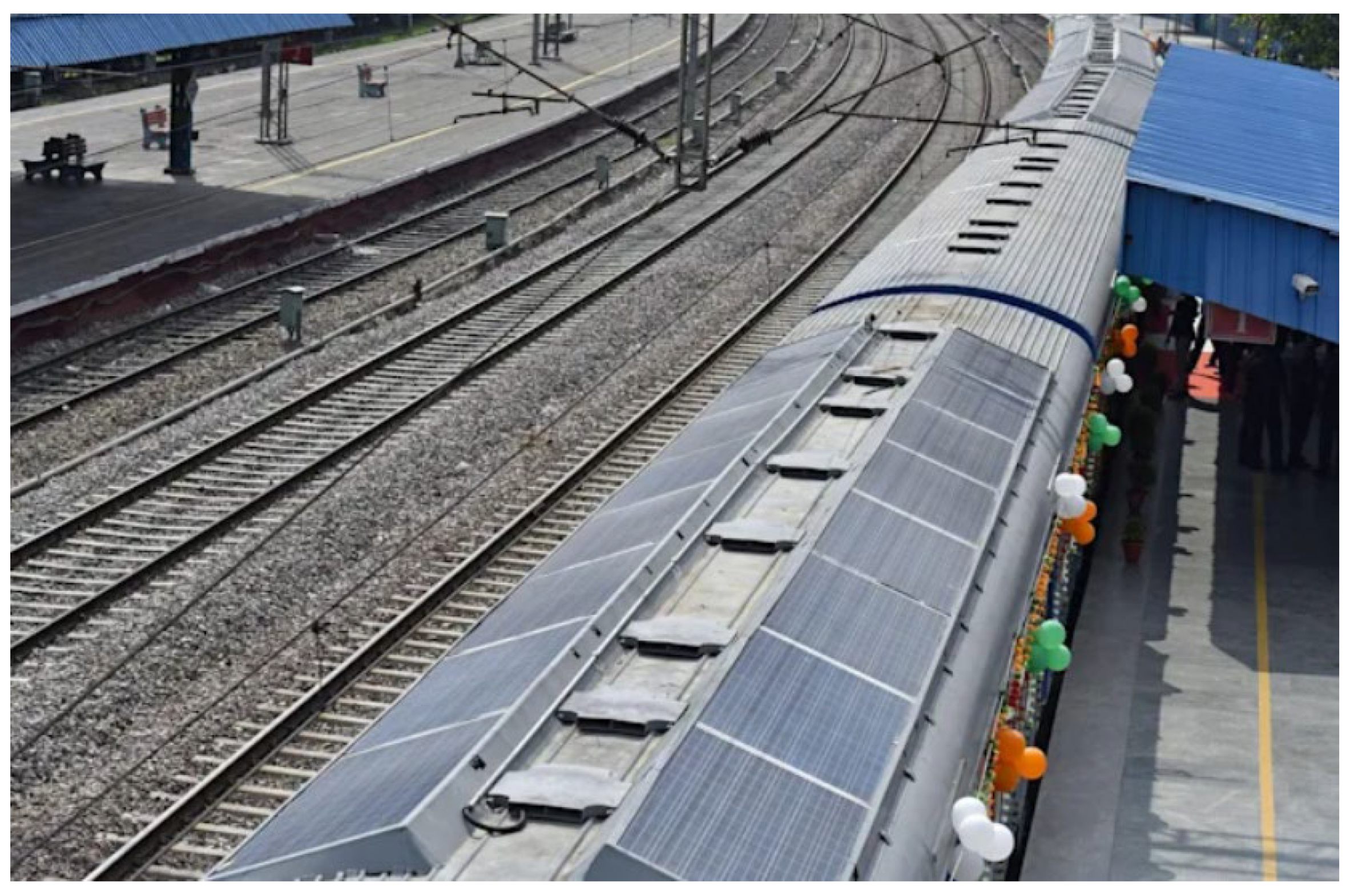



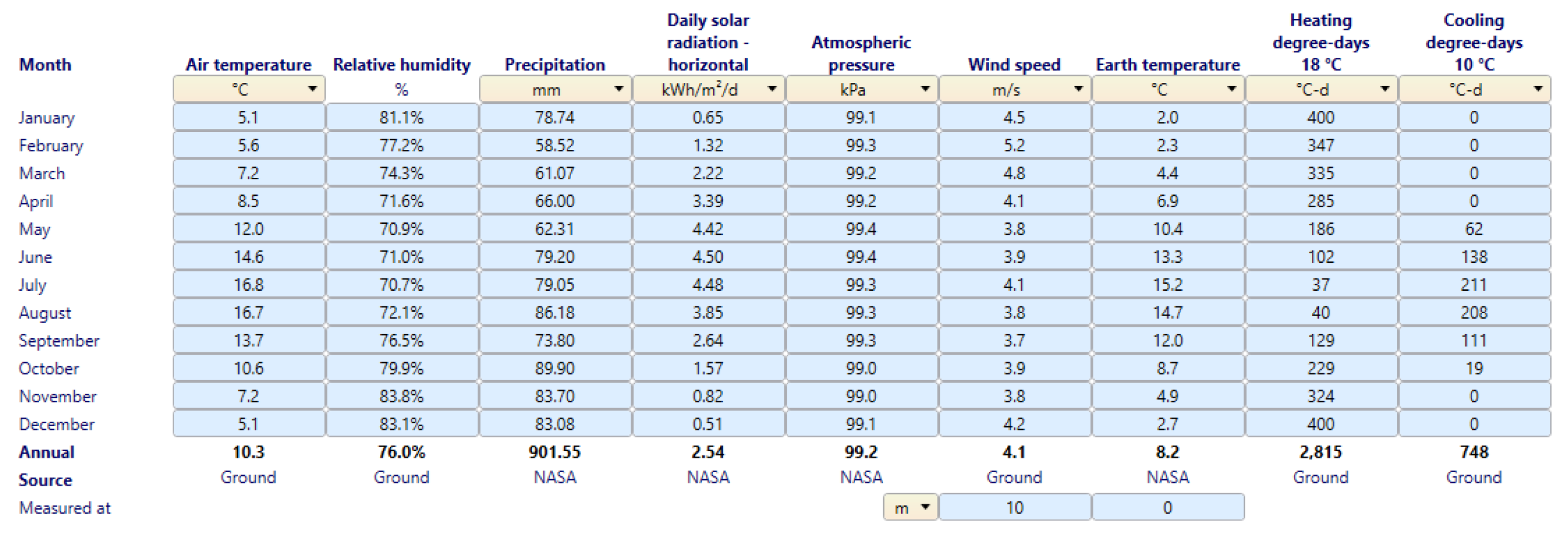
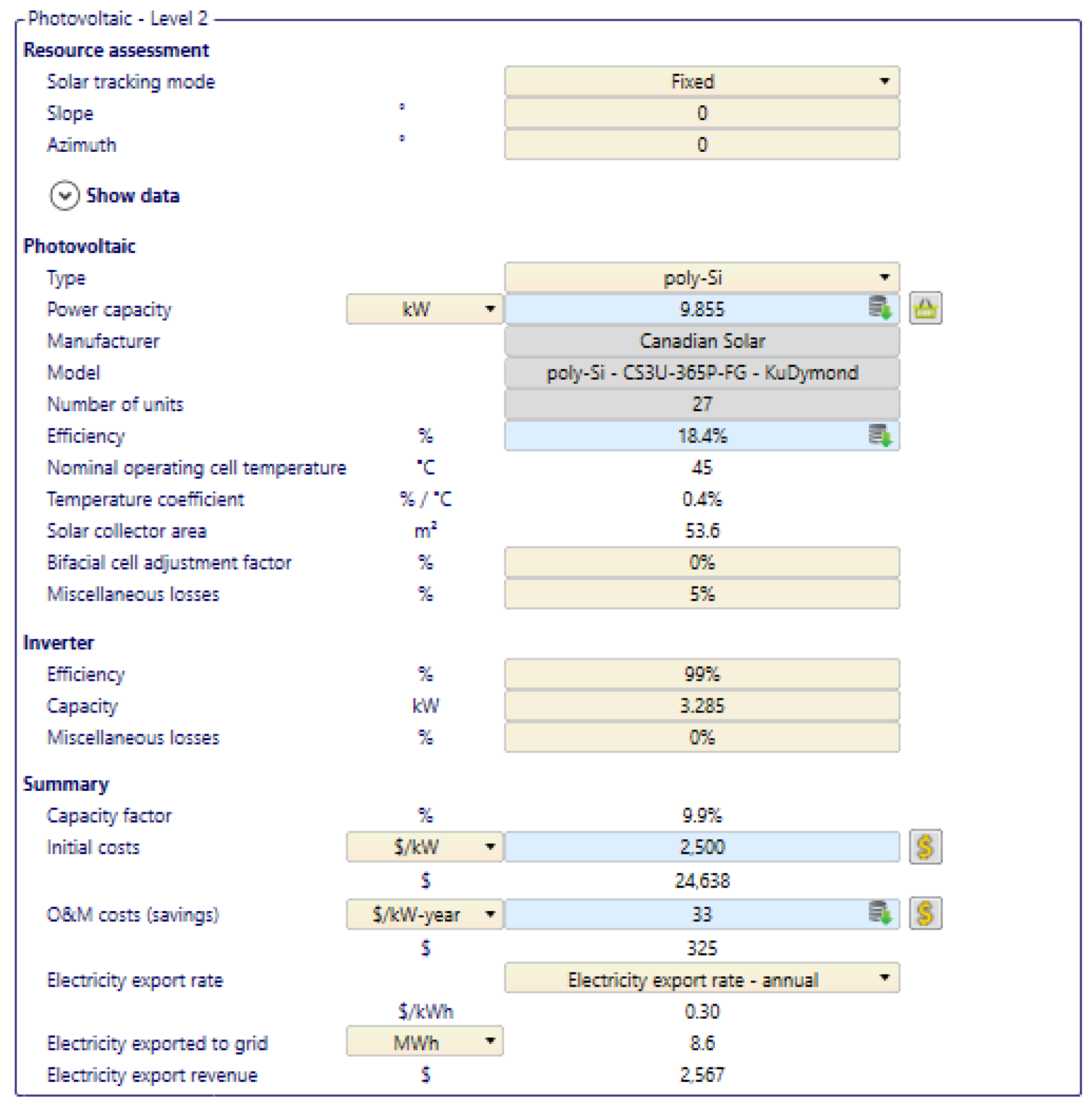
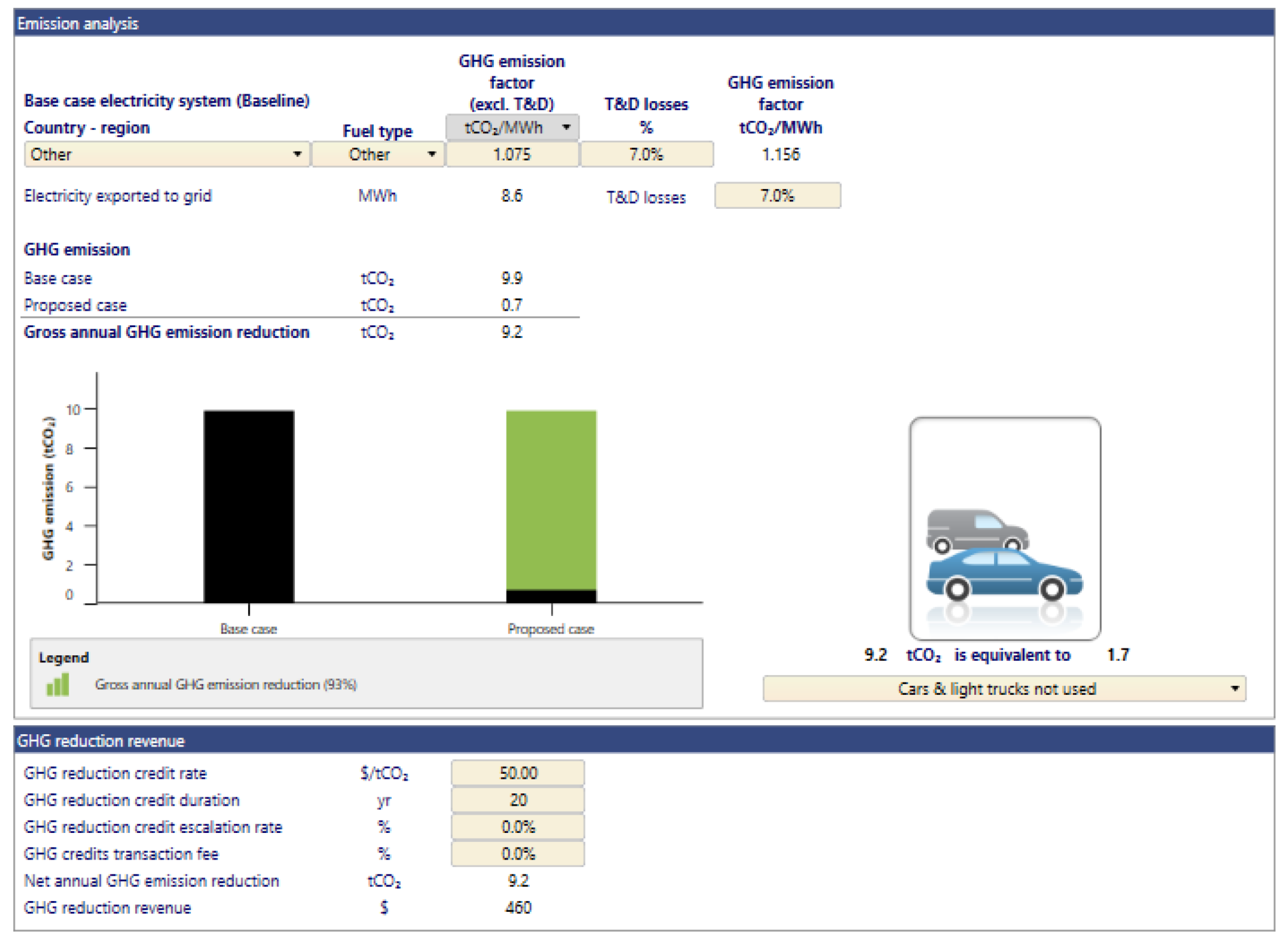
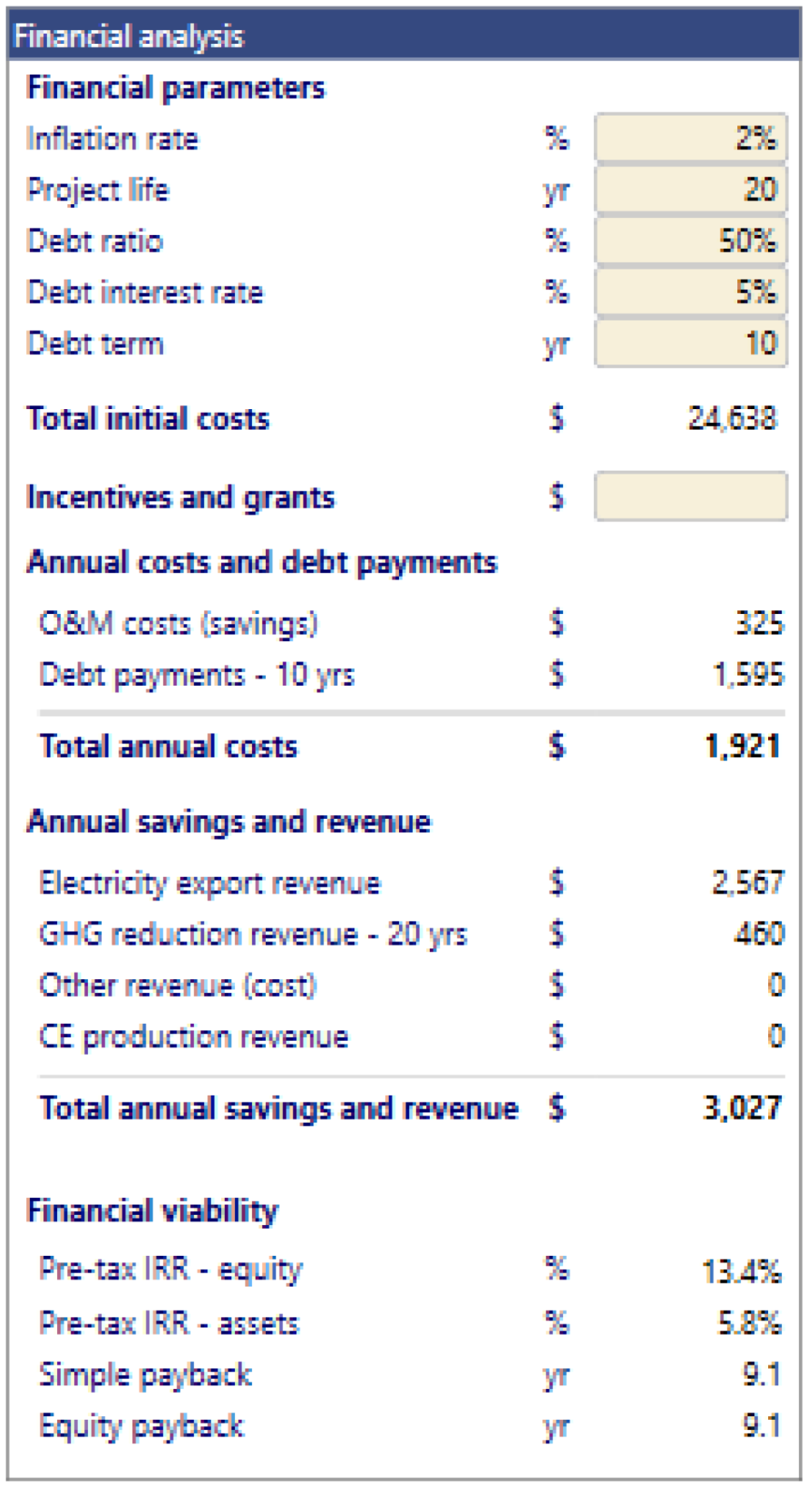
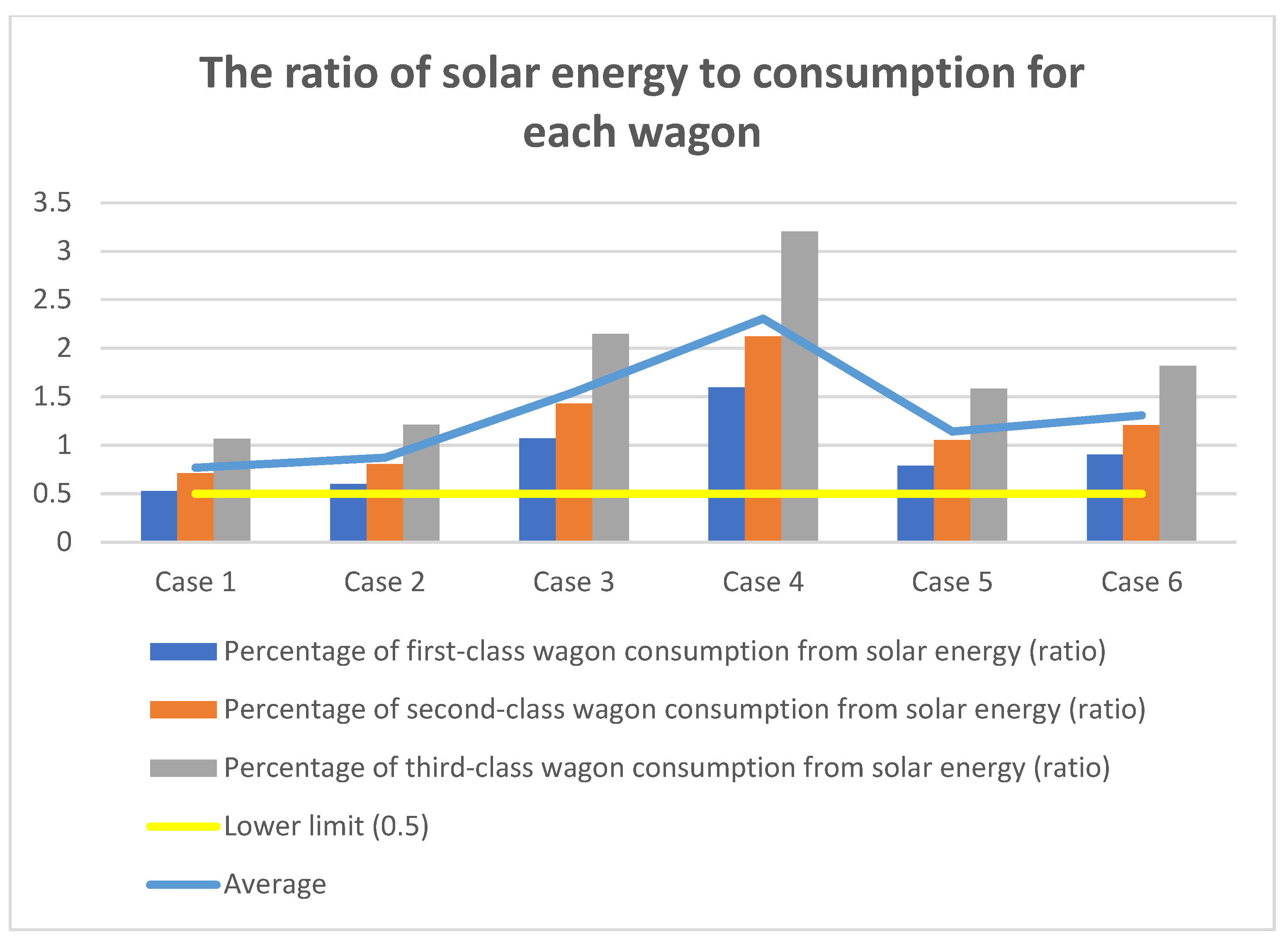
| Global Installed PV Power (GW) | 2016 | 2017 | 2018 | 2019 | 2020 |
|---|---|---|---|---|---|
| OnGrid | 294.8 | 389.579 | 482.912 | 583.872 | 709.674 |
| OffGrid | 2.278 | 2.908 | 3.61 | 4.059 | 4.293 |
| Case Study | Location | Duration of Each Travel (h) | Number of Travels per Week | |
|---|---|---|---|---|
| Case 1 | London to Edinburgh | Southeast of Great Britain | 9.2 h | 7 |
| Case 2 | Toronto to Montreal | Southwest of the province of Quebec—Ontario, Canada | 5.38 h | 14 |
| Case 3 | Sept-Îles to Schefferville | Northern of the province of Quebec, Canada | 10 h | 4 |
| Case 4 | Luxor to Aswan | South of the capital Cairo, Egypt | 3.33 h | 14 |
| Case 5 | Sydney to Henty | The southeastern coast of Australia | 5.33 h | 14 |
| Case 6 | Champaign to Chicago | Southwestern tip of Lake Michigan-USA | 8.33 h | 7 |
| Train’s Car Consumption (W) | 3rd Class | 2nd Class | 1st Class |
|---|---|---|---|
| Lights | 400 | 600 | 800 |
| Heating System | 500 | 1000 | 1500 |
| Laptops | 200 | 450 | 600 |
| Internet Router | 10 | 20 | 20 |
| Phones | 125 | 375 | 500 |
| Sound System | 95 | 95 | 95 |
| Coffee machine | 800 | 800 | 800 |
| Refrigerator | 265 | 265 | 500 |
| Total | 2395 | 3605 | 4815 |
| Case Study | 3rd Class (MWh) | 2nd Class (MWh) | 1st Class (MWh) | |
|---|---|---|---|---|
| Case 1 | London to Edinburgh | 8.06 | 12.14 | 16.21 |
| Case 2 | Toronto to Montreal | 9.59 | 14.43 | 19.28 |
| Case 3 | Sept-Îles to Schefferville | 4.98 | 7.50 | 10.02 |
| Case 4 | Luxor to Aswan | 5.81 | 8.74 | 11.67 |
| Case 5 | Sydney to Henty | 9.29 | 13.99 | 18.68 |
| Case 6 | Champaign to Chicago | 7.26 | 10.93 | 14.60 |
| Case Number | Journey | Capacity Factor (%) | Annual Solar Production (MWh) | ROI (Years) | CO2 Yearly Emission Reduction Revenues ($) |
|---|---|---|---|---|---|
| 1 | From London to Edinburgh | 9.9 | 8.6 | 9.1 | 460 |
| 2 | From Toronto to Montreal | 13.9 | 11.6 | 4.9 | 644 |
| 3 | From Sept-Îles to Schefferville | 12.4 | 10.7 | 6.0 | 574 |
| 4 | From Luxor to Aswan | 21.5 | 18.6 | 2.5 | 998 |
| 5 | From Sydney to Henty | 17.0 | 14.7 | 3.5 | 790 |
| 6 | From Champaign to Chicago | 15.3 | 13.2 | 4.2 | 710 |
Publisher’s Note: MDPI stays neutral with regard to jurisdictional claims in published maps and institutional affiliations. |
© 2022 by the authors. Licensee MDPI, Basel, Switzerland. This article is an open access article distributed under the terms and conditions of the Creative Commons Attribution (CC BY) license (https://creativecommons.org/licenses/by/4.0/).
Share and Cite
Fayad, A.; Ibrahim, H.; Ilinca, A.; Sattarpanah Karganroudi, S.; Issa, M. Energy Efficiency Improvement of Diesel–Electric Trains Using Solar Energy: A Feasibility Study. Appl. Sci. 2022, 12, 5869. https://doi.org/10.3390/app12125869
Fayad A, Ibrahim H, Ilinca A, Sattarpanah Karganroudi S, Issa M. Energy Efficiency Improvement of Diesel–Electric Trains Using Solar Energy: A Feasibility Study. Applied Sciences. 2022; 12(12):5869. https://doi.org/10.3390/app12125869
Chicago/Turabian StyleFayad, Ahmad, Hussein Ibrahim, Adrian Ilinca, Sasan Sattarpanah Karganroudi, and Mohamad Issa. 2022. "Energy Efficiency Improvement of Diesel–Electric Trains Using Solar Energy: A Feasibility Study" Applied Sciences 12, no. 12: 5869. https://doi.org/10.3390/app12125869
APA StyleFayad, A., Ibrahim, H., Ilinca, A., Sattarpanah Karganroudi, S., & Issa, M. (2022). Energy Efficiency Improvement of Diesel–Electric Trains Using Solar Energy: A Feasibility Study. Applied Sciences, 12(12), 5869. https://doi.org/10.3390/app12125869









